
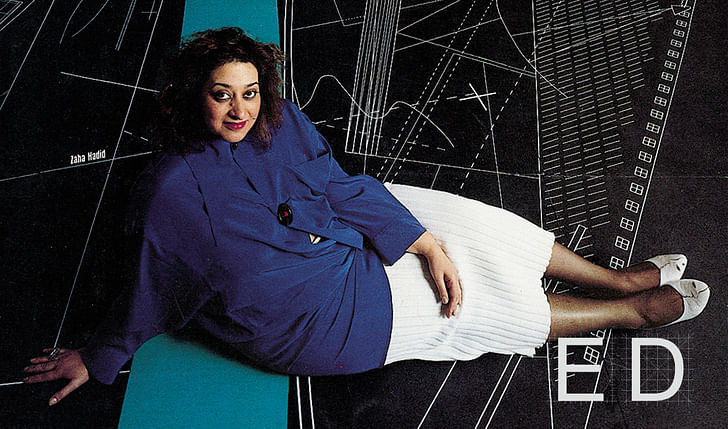
I1 heard a lot of stories from my friend about Zaha, like: she had a giant red couch that all of her interns had sex on; she installed a phone in the studio at Cooper Union so she could call her students at all hours of the night and ensure they were working; she too stayed up all night in London painting and watching American Gigolo on repeat2, inviting famous artists and architects in to visit her; she was spotted at the Venice Biennale standing alone in a room on top of a world map projection, hands spread out, hair blown by a fan; or, most curiously, that she sat outside, sweating in Venice while shoving pizza into her face. My friend swears that the folds of the pizza slice collapsing into the folded skin of her face looked just like one of her buildings.
These rumors aren’t just the lore of architectural celebrity exchanged in architecture studios at 2 a.m. They contribute to a cult of personality that binds Zaha’s person to her work, an amalgam strengthened by her appearances on and within glossy covers from Domus to Time. It’s this mythic version of the woman that is seared into the popular imaginary:
“The sandwich came with potato chips, and Hadid examined one, turning it in her fingers, which were long and tapered and ended in bright-red nails, before putting it into her mouth. The twisty geometry of an ordinary potato chip, to say nothing of the curves in modern cars and phones, is a reminder of how few buildings look as if they belonged in the digital world. Hadid is devoted to helping architecture catch up.”3 (The New Yorker)
Rumors range from the quirky, to the sexual,4 5 6 to the downright bizarre.7 She never actually had to engage in her own self-promotion for her image to proliferate, and still she was constantly interviewed. Rather, she embraced the rumor—that often nasty, persistent hum known particularly for lingering around women—to quietly make the space around and between her and her architecture even greater. Resigned to a public image in and beyond architecture that would never fully grant her credibility, despite how her work enraptured publics, she absorbed gossip such that she became a mythic constellation of ‘all press is good press,’ a New Yorker cartoon of a woman.
Before her death, Zaha had stated that there was “nothing individual” or self-serving about her work. She said she had “always believed in creativity’s role in architecture” as if creativity was a force untethered from the individual artist.8 9 It’s difficult to take this claim seriously, but there is something to be said about the way that artist and art are made to convene in such a statement. The image of the architect and their architecture-as-image are mutually produced, even by the effort to separate them. This co-constitution yields an aura of recognition that transcends both the author and the work—to such an extent, in this case, that her influence is registered in places she hasn’t designed, even in the folds of her face. After all, it’s the image of Zaha, draped in heavy fabrics, that secures the triumphant reality in which she builds. In one photoshoot or another, she gazes down at the camera, daring audiences new and familiar to underestimate her. And that’s not just something I heard.
The cult-image of the architect exceeds any one building, but it too is designed. Architecture’s heroes—especially those that cross over from the insular genre of design discourse and into the mainstream glow of popular consciousness—are not disengaged from the project of their own image-making. Even as mainstream recognition is held up as further evidence of their credibility as architects, the double-effort of branding architecture and self is a project less often open to critique, despite how often it drives commissions or appearances behind lecterns.
The apparatus of fame is designed in a series of self-securing gestures. Linking the architect inextricably to their work, this operational image permits—or denies—them the celebrity credentials to circulate both in the world of luxury commodities and on the trying academic circuit. Despite the idiosyncrasies that distinguish architecture’s most famous, the figuring of architectural renown still depends on an outdated notion of creative heroism, one that less readily acknowledges collaboration, parallel architectural histories, or methodologies outside of the conventional disciplinary lineage. In the interest of centering practices outside the typical purview of conventional (white, male, moneyed) acclaim, it’s worth examining the techniques by which architects reinforce the trope of the auteur in the design of their own celebrity. What are the techniques by which celebrity can be re-designed?
Beatriz Colomina discusses this image-making project at length in her essay “Mies Not.” Here she discovers Mies van der Rohe as a strategic representation of himself in his work within a range of forms: “exhibitions, catalogues, books, architectural magazines, competitions, photographs, world’s fairs, journalism, museums, art galleries, conferences, architectural schools, and so on...” that configure him not just as an individual but as an apparatus for conjuring the most appropriate public image.10 In fact, the most contemporary thing about Mies might not be his trademark use of “glass, steel or reinforced concrete as it is usually understood,” but rather his engagement “with the media.”11
His works are better read in the event of their publication than the context of a construction site. His most famous pavilion was “barely seen by anyone” when it debuted and was asserted in the discourse as a series of images before it was reconstructed as a matter of architectural history in the 1980s.12 We came to celebrate Mies the master builder despite the immateriality of his most prolific work, and that’s owed to his efforts to render himself as such. He emphasized his past as a stonemason,13 a rumor he circulated himself, and he consistently positioned himself in photographs near to a model he was probably not responsible for making. The popularity of Mies, and the endurance of this image, extends beyond the grave; a feature-length film will resuscitate his image again in 2017, with Jeff Bridges dramatizing his role opposite Maggie Gyllenhaal's Edith Farnsworth.14

As an image of his own making, the heroic architect can circulate in further legitimating spaces: in the economic space of practice, in lionizing disciplinary space, and in the echo chambers of architectural history. Each lends to the amplification of prestige, relevance, and billings, further cementing individual acclaim in the imbricated value systems of cultural and economic capital. But for whom does this apparatus work beyond Mies or Koolhaas or Liebeskind?
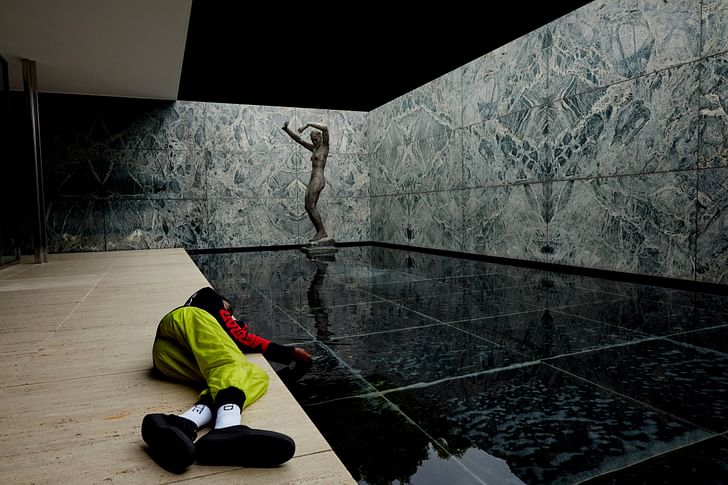
Virgil Abloh is one such creative practitioner who has made use of the qualification ‘architect-trained’ if not ‘architect’ to hack the design of his celebrity.16 His lecture “Everything in Quotes” at GSAPP earlier this year was awash in irony, with his casual embrace of his education appearing in a series of slides from an Off-White™ photoshoot in Mies’ pavilion. The scare-quotes acknowledge some of the referential distance in the renegotiated image of a replica of Mies’ most enduring work, one that becomes newly accessible in the terrain of ‘streetwear.’ Quotes also help to contain a distinct body of work, one mostly gathered from elsewheres: artifacts like pyrex, the stock exchange ticker, the Rugby flannel shirt, and stacks of drywall sheets are submitted to his aesthetic regime as they are added to the composite of his own image. In the company of Ken Frampton and other Avery Hall illuminati, he played video of his show at Paris Fashion Week accompanied by John Berger’s “Ways of Seeing” and Migo’s “T-Shirt” (“do it for the culture / they gon’ bite like vultures”); he passed around a sample sneaker from his new Nike collab and responded to questions from a line of young men who might as well have been waiting outside a Supreme. Pausing in between to take photos of the audience, he acknowledged the novelty of the event—which is documented between DJ sets in Stockholm and Berlin on his instagram timeline. Neither white nor black, but Off-White™, Virgil’s practice effectively designs novelty (including his own) out of the conscious appropriation of terms and symbols between opposing sides of a cultural and generational divide.17
Virgil’s association with Kanye West, the rapper who once stood on a desk at the GSD proclaiming that “everything needs to actually be architected,”18 reinforces his more appealing position beyond the operation space of mainstream architecture to a profession which is increasingly looking outside of itself for inspiration and ways to exceed its own stifling whiteness.
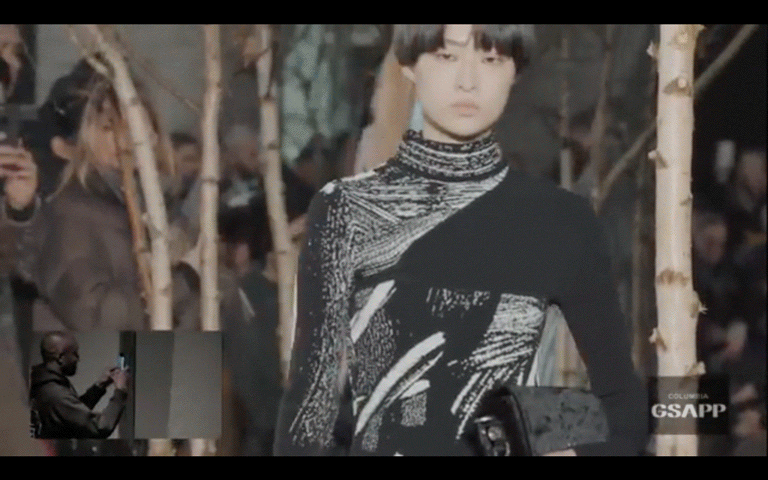
Virgil and his young black fandom and his gender-ambivalent clothing line testify to the fact that architectural celebrity has gained some feminist distance from Corb bothering Josephine Baker on a cruise ship.19 But I wonder how architects as public figures, imaginaries and celebrities—especially those historically underrepresented within the discipline—visibly occupy the current moment as dignitaries among our contemporary popular culture. Virgil asking to turn up the Migos in Wood auditorium certainly seems to disrupt staid appearances by architects under lecture-hall lights. But he capitalizes on a kind of auteur-heroism that has not altogether left the room, especially when Kanye “I am a God” West has christened him ‘Creative Director’ in this age of architectural necessity. We need these black heroics, especially in annals of architecture—but is it ever possible to disband with the baggage of our longstanding auteur complex?
The image of the architect is one that continues to leverage a heroics rooted in the narrative of modernism. A story that takes shape in parallel to film, the plan is an image easily supplanted by a man in a wool suit as the salve for the social and cultural ills of the 20th century. Gary Cooper as Howard Roark is still slamming his fist on the table, but this table, now stacked high with back-issues of Pin-Up and empty boxes of American Spirits, is no longer surrounded by the more obvious villain of the banker. His exertion of creative will against the mediocre tastes of corporate power (“a building has integrity, just like a man, and just as seldom!”20), or despite the silent protests of Dominique Francon,21 don’t feel so distant. In Ayn Rand’s telling, Howard’s commitment to his vision is a heroic expression of architectural individualism, a value that certainly maintains its place in this late hour of neoliberalism and under the dominion of master-builder Donald. Ayn’s notion of ethical egoism, which justifies individual success at the expense of collective achievement, certainly has its contemporary representatives.

Take the example of Bjarke Ingels, who recently endeared himself to millions (of my non-architect/male-attracted friends) when he appeared on the Netflix series Abstract: The Art of Design, and who is set to star in a full length feature documentary this month. Before he enjoyed popular fame, Bjarke’s anti-monograph Yes is More: An Archicomic on Architectural Evolution was a tool that framed both him and his architecture as the ‘most evolved’ manifestations within the history of architecture. The success of Yes is More can in part be attributed to its mass-market format, but is also owed to positioning (his) architecture as a necessary transformation of design for broader appeal.23
In Yes is More, he is figured as the protagonist in the struggle between “traditionalism” and a new kind of architecture. This drama is rendered in high contrast graphics and in the frantic italics of hand-lettered captions that describe their projects in moralizing terms. “It was part junior sailing club, part social project, meant to teach the local kids to rig sails and knots rather than steal cars or paint graffiti” says one set of frames about the Maritime Youth House. [X] no to brown graffiti artists, [✓] yes to white sailors the graphics, the image reads.24
As the comic book’s author and superhero, he draws himself and his architecture into a modernist heroics adapted for both the current moment in architecture and for a nostalgia that exceeds the discipline (a boy and his comic book). An eschewal of the conventional monograph, which submits a body of work to the object form of the book, Bjarke constructs a narrative in which he himself appears as part of that stylized body. He is the BIG.dk (the URL of his practice) thrusting toward an ‘evolved’ architecture, what he calls the “fertile overlap” between the pragmatic and the utopian.25 I can think of a no more ‘pragmatic utopia’ from his point of view than an office that engineers his fame and doesn’t pay its interns a living wage26—presumably, the privilege of working at BIG is compensation enough.27
His office is predicated on his name and his potent image: something that can be traded without the design, without the interference of his partners, and without ever acknowledging his junior associates and interns, in other words, the whole ecology of labor that supports BIG. As Bjarke himself states in Yes is More, “Telling your clients that they can get anything they want turned out to be a successful strategy and we won the competition without an actual design.” Yes is actually nothing. Bjarke escalates Miesian immateriality to the obscene extent that only the Netflix generation can appreciate: he has transformed himself into capital, a value-added entity that doesn’t just support the design, but is wholly interchangeable with a project in its abstract form. This transformation engenders a form of appeal that has neither the sincerity of utopia nor the expedience of the pragmatic, only the recursive self-indulgence of late capitalist consumption. If anything, Yes is More is the popcorn blockbuster that promises the possibility of return to the culture of old man architecture: an individualized practice rapidly eroded by a distribution of labor that promises cheaper and faster construction and a more diverse set of interlocutors and interests expanding the field in unknown directions.
It’s no surprise that this formula no longer succeeds in producing Zahas. Despite the efforts to self-image by Bjarkes (men already helped by other privileges; men not starved for patronage), the generation led into ‘mainstream’ practice by the aspirational but distant glamour of the starchitect has failed to nominate new darlings. The distributed office and the necessity of collaboration no longer permit the triumph of ego. And young single-name practices rarely gather enough resources to leverage their own acclaim in competition—either in the economy of practice or in the economy of attention. Rather, we re-consecrate the cult image of the auteur-architect post-mortem because its mythology delights. We continue to insist on the image of Zaha fingering the double-curvature of a potato chip with a lacquered nail because what could be better? An actual building? Her acknowledging the role of architecture in orchestrating dehumanizing labor practices?
Bereft of our imperfect hero, we feel owed some new architectural Beyoncé. But we fail to acknowledge that she would only preside over a discipline modeled on mentorship that still fails to advance its underrepresented practitioners, or adequately address it own politics, much less the social ills of the 21st century. Zaha was always reluctant to be a symbol for other women in the profession; for most of her career, she found the title ‘woman architect’ to be diminishing.28 And when Kendall Jenner diminishes the work of Black Lives Matter with a can of Pepsi,29 and Elisabeth Moss can’t even admit that the Handmaid’s Tale is FEMINIST,30 it’s clear that our celebrities are never actually accountable to their ‘ideological work,’ nor can they adequately reflect the changing values of contemporary popular culture or the discipline of architecture.
As members of a ‘following’ public, we are also responsible for our heroes—in part because the desire for the hero is a desire for our own celebrity, for a follow-back. Both the Twitter-verified and their now quantifiable fandoms occupy a media context where we can all be assured of our own small small slice of stardom and our own ability to self-image. Our fascinations with the individual of note are entangled in the manufacture of apolitical fame.
Virgil Abloh’s re-use of the image-apparatus of fame takes place in a system wherein image-production is only ever obvious, and he's openly adopting it such that irony itself becomes the technique de rigeur. In the era of the meme, the Snapchat filter, and the search-engine recursivity of the image, we’ve become all too aware of the techniques of self-invention. Everyone on Instagram has a personal brand, and ‘identity design’ appears more frequently under the list of projects on the websites of young architects.31 It’s the distribution and acceleration of the techniques of self-promotion that has made the individual arch-hero impossible to take seriously.
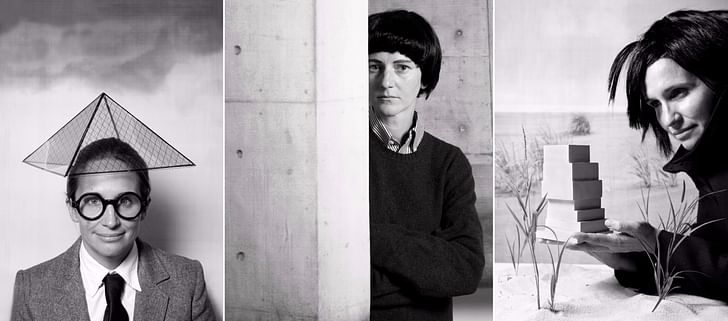
A question we probably could have asked a decade ago was: how can architects who are not Rem, cis-male or white make themselves visible within this expanded field of reception? But in this moment I’ll ask: how might we attend to more urgent issues beyond self-promotion at a time when architecture has increasingly less economic power and political coherence? We could all dance on the grave of the author, if only to summon more redolent images of collaboration, of subversion, or of meaningful architectural action. If the death of the author is an opportunity to usher in not just new actors, but new work, how can the power to image be exploited outside of the self-serving matrix of fame?
At the VERY least, we can put these techniques to use.
Akoaki is a firm that you may not have heard of, but its partners—Anya Sirota and Jean Louis Farges—are subjecting the curious techniques of imaging acclaim not to themselves or any one person, but to institutions pre-existing and invented. Rather than solely designing a built architecture for people to form around, they figure institutions that attract and build communities that become part of the design process. Beyond any familiar act of identity design, their projects convey the appearance of cultural capital in its institutional form, not only on behalf of the architect.
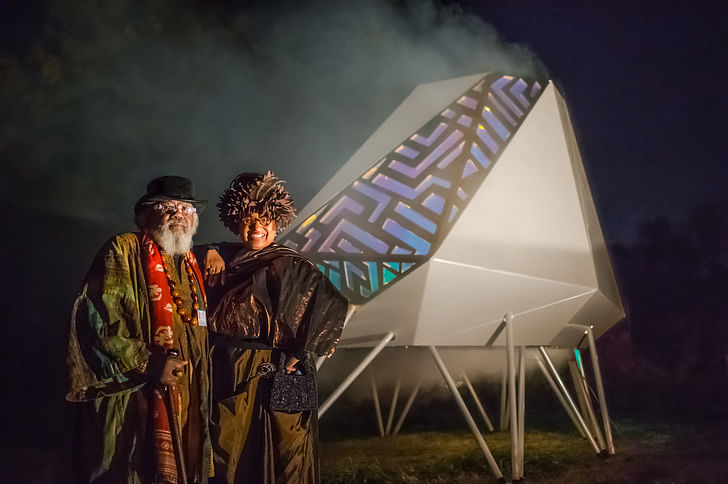
Their work in Detroit is playfully rendered (see the funkadelic “Mothership”), but it takes on serious risks and challenges. The installation-event “Imaging Detroit”32 was slated to appear on a Fox News segment, but a shooting in Detroit around the same time was reported at the last minute instead. Operating against the appeal of ruin porn and other suggestions of ‘inner city violence’ to suburban Detroit (the products of decades of white flight) and beyond, Akoaki instead produce counter-images of a diminished community.
The infrastructures designed by Akoaki alongside Detroit’s cultural emissaries capitalize on the power of rumor, myth, and the capacity of architectural imaging to form not just newly built scenes, but new institutions and images that culminate in widely-supported, highly effective, and visible projects. Their project “ONE Mile” re-enacts an origin story of Detroit culture: ten nights of performances at the Phelps Lounge are recounted in Bettye Lavette’s memoir when George Clinton (of Parliament Funkadelic fame, nicknamed "the Prime Minister of Funk" and "Dr. Funkenstein") changed music forever. Along this same stretch of Oakland Avenue, landscapes, buildings, objects and artifacts are designed and deployed as a matter of collective authorship. ONE Mile is a system of re-consecration and re-investment, a tool for laundering cultural capital in order to further “support the cultural production and socio-economic activity of Detroit’s epic North End neighborhood,” including and beyond myths of funk.33
In Akoaki’s telling, nomadic scenographies and cultural councils form an architecture capable of broadcasting under-exposed narratives about Detroit—its workers, cultural producers, and histories.34 Architecture has the capacity to “animate,” particularly through designed infrastructures that that can adapt to changing users and situations in informal ways. Many of the built projects Akoaki undertakes are accompanied by institutional redesign. For example, their organization Metropolitan Observatory for Digital Culture and Representation (MODCaR) transformed a vacant barbershop in Detroit to not only construct a gallery and community space, but to formalize the barbershop as a community institution, naming it the Bureau of Emergent Urbanity. The barbershop is a long-recognized cultural space in the black community, but one that is often unrecognized by museums or academic institutions who fund and legitimize cultural production. Here, the architect can intervene to produce the evidence of legitimacy, credibility, and capacities to render them legible to existing systems of power, facilitating the redistribution of power that architects often mediate, but usually towards their own ends.
One last thing to cement Akoaki in this select pantheon of celebs: I heard they received funding to design a biennial in France and they used it to fly thirty North-Enders with expedited passports there with them—not just as subjects of research, but as crucial collaborators!35
To find out more about the project, get your hands on a copy of Ed #1 The Architecture of Architecture here!
1. ‘I’ as in ‘we’: feminist architecture collaborative, the collective auteur of this essay.
2. Britain’s most outspoken architect divulged that, at the age of nine, she designed her own bedroom (“it was kind of modernist, wooden…I was quite fussy, so my mother said, listen, you do it”), that she knew “every move Richard Gere made” in the film American Gigolo and that she used to sing “non-professionally.” "The Rake’s progress: last week in gossip," Apollo Magazine, March 04, 2016, accessed June 15, 2017, https://www.apollo-magazine.com/the-rakes-progress-last-week-in-gossip-5/.
3. John Seabrook, “The Abstractionist,” The New Yorker, December 21, 2009, accessed June 15, 2017, http://www.newyorker.com/magazine/2009/12/21/the-abstractionist.
4. “She's a temperamental figure with a reputation for tantrums and sulks. Yet she's simultaneously a woman of magnetic charisma who sucks flirtatiously on her Starbucks frappuccino while icon's photographer changes film.” Marcus Fairs, “’I don't have an identity,’ declares Zaha Hadid,’ Icon, accessed June 15, 2017, https://www.iconeye.com/404/item/2739-zaha-hadid-%7C-icon-003-%7C-june-2003.
5. “A fantastic rumour circulated on the Internet this week that Pritzker winner and eligible bachelorette Zaha Hadid had married her long-time design partner Patrik Schumacher. There was even a suspect image of Zaha supposedly at her wedding with Schumacher, Frank Gehry and Brad Pitt. But according to Hadid’s press office, the rumor ‘couldn’t be further from the truth.’” “Concrete Boots,” Building.co.uk, accessed June 15, 2017, http://www.building.co.uk/Story.aspx?storyCode=3051049.
6. “Every time I met Zaha Hadid, she was surrounded by coterie of young beautiful men who served her as if she were a queen.” - Christina Ruiz (@resea99), Editor At Large The Art Newspaper; Contributing Editor The Gentlewoman; Contributor FT, Time, Vanity Fair UK.
7. “Everyone called her Zaha, and she tended to address the people she really appreciated with a label of her own confection—‘Potato,’ ‘Dumb-Dumb,’ ‘Wiggles.’ She could lob nicknames like cotton candy into particularly thorny situations — over an intercom system or across an auditorium, whipping the mood to a sugary high. I desperately awaited my treat.” Pierre-Alexandre de Looz, “Call Her Zaha,” Pin-Up, Fall/Winter 2016/17, accessed June 15, 2017, http://pinupmagazine.org/2017/01/call-her-zaha/.
8. "Architecture is not a medium of personal expression for me," she said. "To interpret it as striving for individual expression is to misunderstand it. This misunderstanding is often linked to the dismissal of my work as self-indulgent or willful." Zaha Hadid at her Royal Gold Medal Lecture.
9. "I have always believed in progress and in creativity's role in progress," she said. "That's why I remain critical of any traditionalism." Zaha Hadid at her Royal Gold Medal Lecture.
10. Beatriz Colomina, “Mies Not,” in Presence of Mies, ed. Detlef Mertins (Princeton, NJ: Princeton Architectural Press, 1994), 181.
11. Colomina, 179.
12. George Dodds, Building Desire: On the Barcelona Pavilion (New York: Routledge, 2005). Dodds book encounters the pavilion as a mythic assemblage of words and images.
13. Apparently, Mies’ father was the real stonemason, but he felt justified in claiming credit as a craftsman, bragging to his friends about buildings that were “really buildings” and “not paper architecture.” He served as an apprentice bricklayer for a local builder for one year, during which time he mostly fetched water for people, an uncompensated duty. After he demanded payment and the company refused, he left and became a draftsman. Colomina, 171.
14. Dan Howarth, “Jeff Bridges to Star in Movie about Mies Van Der Rohe's Farnsworth House,” Dezeen, accessed February 11, 2017, https://www.dezeen.com/2017/02/08/mies-van-der-rohe-farnsworth-house-hollywood-movie-jeff-bridges-maggie-gyllenhaal-residential-architecture-usa/.
15. A series of books he’s working on features models wearing his clothes inside iconic architectural landmarks, such as Mies van der Rohe’s Barcelona Pavilion. “The idea is to teach my demographic about architecture through buildings that have inspired my way of thinking. I want to put culture on a track so that it becomes more inclusive, more open source. And then give kids the chance to ride in the express lane.” Diane Solway, “Virgil Abloh and His Army of Disruptors: How He Became the King of Social Media Superinfluencers,” W Magazine, April 20, 2017, accessed June 15, 2017, https://www.wmagazine.com/story/virgil-abloh-off-white-kanye-west-raf-simons.
16. “Virgil Abloh likes to talk. He possesses an unusual, not-quite-sure-if-he-means-it talent for the gnomic monologue, holding forth on how he is ‘kicking dents in culture’ and represents a kind of fashion that is ‘post-Tumblr, post–street style,’ and how his lauded label Off-White isn’t fashion exactly but rather a ‘platform’ for his being a ‘creative.’” Carl Swanson, “What Does Virgil Abloh Know?” New York Magazine, February 7, 2017, accessed June 15, 2017, https://www.thecut.com/2017/02/virgil-abloh-off-white-streetwear.html.
17. “Streetwear,” another term he submits to quotes was something that originally irked him. “‘Streetwear’ is basically a code name for ‘people without resources’ creating to make something that resonates with their demographic, not necessarily the one above it. So it’s a mainstay in my work. I used to run from the term, but since it got used in reference to my work, I’ve embraced it, because I want to define it.” https://youtu.be/nkMWMBsCd9k?t=1803, 30:32-31:24.
18. Kriston Capps, “Architecture Could Use Some Help From Kanye West,” Slate Magazine, November 19, 2013, accessed June 15, 2017, http://www.slate.com/blogs/browbeat/2013/11/19/kanye_west_speaks_on_architecture_at_harvard_graduate_school_of_design_more.html.
19. Ann Cheng, Second Skin (New York: Oxford University Press, 2010), 90.
20. Howard Roark Refuses to Compromise. https://www.youtube.com/watch?v=ClYDwE2Obnk
21. Lest you forget about the book’s notable rape scene.
22. “It’s almost like a shaman with brick and mortar,” says Bjarke in the Netflix documentary Abstract.
23. The blurb on the Taschen website reads: "Yes is More is a play on words that represents the company’s ethos and sums up its irreverent attitude towards excessive formalism, and its determination to involved the population at large in its creations. As an extension of its methods and results, its debut monograph uses the most approachable and populist means of communication available—the cartoon."
24. Yes is More, 214.
25. As he puts it, “Architecture seems entrenched between two equally infertile fronts either naively utopian or petrifyingly pragmatic. Rather than choosing one over the other, BIG operates in the fertile overlap between the two opposites. A pragmatic utopian architecture that takes on the creation of socially, economically and environmentally perfect places as a practical objective.”
26. “Bjarke Ingels Group NYC Intern Salaries,” Glass Door, last modified June 10, 2017, https://www.glassdoor.com/Intern-Salary/Bjarke-Ingels-Group-NYC-Internship-Salary-E612483.htm.
27. Amy Frearson, “Bjarke Ingels Impressed by Graduate's Video Job Application,” Dezeen, February 8, 2016, accessed June 15, 2017, https://www.dezeen.com/2016/02/08/etienne-duval-yo-is-more-big-graduate-job-application-bjarke-ingels-youtube-video/.
28. Zaha says in a CNN interview: “I used to not like being called a ‘woman architect.’ I am an architect, not just a woman architect. But, I see an incredible amount of need from other women for reassurance that it can be done, so I don’t mind anymore.” Despina Stratigakos, Where are the Women Architects? (Princeton, NJ: Princeton University Press, 2016), 64.
29. Daniel Victor, “Pepsi Pulls Ad Accused of Trivializing Black Lives Matter,” The New York Times, April 5, 2017, accessed June 15, 2017, https://www.nytimes.com/2017/04/05/business/kendall-jenner-pepsi-ad.html?_r=0.
30. Alexandra Shwartz, “Yes, ‘The Handmaid's Tale’ Is Feminist,” The New Yorker, April 27, 2017, accessed June 15, 2017, http://www.newyorker.com/culture/cultural-comment/yes-the-handmaids-tale-is-feminist.
31. Design, Bitches “advocates an architecture that is accessible to a broader audience & connected to everyday life” with projects that integrate architectural and interior design with a complete branding strategy. This strategy often devolves into a referential aesthetics to situate a restaurant or an ice cream shop into a more appealing cultural domain where food and entertainment enterprises might not otherwise profit.
32. From Akoaki: “equal parts international film festival and pop-up agora, aimed to spark a conversation about the many ways Detroit has been portrayed over the last decade. It staged public debate and open speculation on how representation contributes to our urban imagination.”
33. “Design is a powerful tool for broadcast. It helps craft spaces, experiences, and images. The O.N.E. Mile project is dedicated to advancing the idea that design can be a catalyst for change. As a result, we design objects, environments, and situations where people can come together in informal, surprising, and inspiring ways. Sure, we love beautiful things. But, design on its own doesn’t stand a chance. It’s a contingent practice, one that needs context, program, and people. As a result, we design in cohorts with activities and scenarios that emerge from a set of urban and cultural circumstances. Happily, the North End is a source of limitless inspiration.”
34. “Akoaki, Out of Site - Carte blanche Biennale Internationale Design 2017,” YouTube, November 28, 2016, accessed June 15, 2017, https://www.youtube.com/watch?v=uzqiQ2cf5Ms.
35. “Out of Site,” Akoaki, accessed June 15, 2017, http://www.akoaki.com/out-of-site.html.
feminist architecture collaborative
feminist architecture collaborative a three-woman architectural research enterprise aimed at disentangling the contemporary spatial politics and technological appearances of bodies, intimately and globally. Their projects traverse theoretical and activist registers to locate new forms of ...
2 Comments
When i first saw this, I thought "who has the time to read this?" ... then I realized that someone had the time to spew this garbage! Get a job, guys. This has absolutely no ramification on your careers.
My lunch break is over and I haven't finished the article, nevermind the footnotes, yet! Can't wait to finish this and mull it over more. Excellent topic, one I referenced *very* clumsily in the last podcast (Arch Sessions #113).
Block this user
Are you sure you want to block this user and hide all related comments throughout the site?
Archinect
This is your first comment on Archinect. Your comment will be visible once approved.